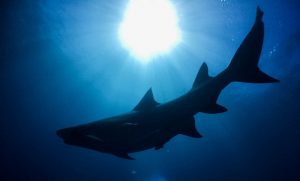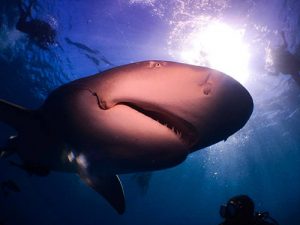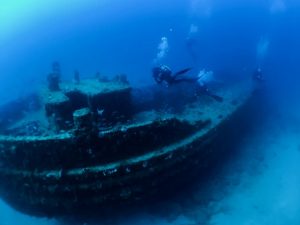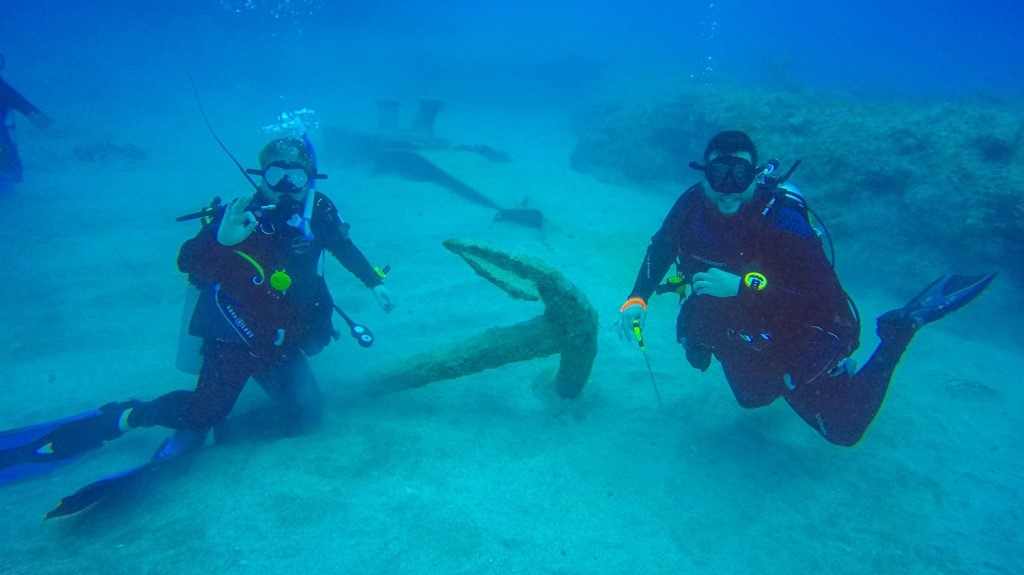Coastal Getaways: Shark Dive in Jupiter
There, about twenty feet away, was a large, bulky bull shark swimming directly toward me. It swam up from the depths, a calm specter who seemed purposeful… eager… hungry.
Time to read: 11 min.Adventure Level: Crazy
If you’re feeling a little more adventurous, head over to Emerald Charters in Jupiter and go on a shark dive. Yes, you read that right, a shark dive. And before you ask — no, there aren’t any cages. Those things are for wimps. What you’ll see: Well, sharks for one. This area of the coast hosts a variety, ranging from lemons, bulls, tigers, and hammerheads, depending on the season.
Beginning
We arrived at the dock early in the AM. There was only one other charter heading out in that section of the docks. We started hauling our gear onto the boat.
Boat atmospheres are always interesting. A sort of relaxed tension more often than not seems to prevail. Military-like strictness and protocols alongside easy jocularity. Jokes are cracked as gear is briskly loaded and anything heavy is tied down and made secure.
At Emerald, the captain was a low-key, relaxed guy named Roger. The deckhand, Johnny, worked as an environmental specialist and spent most of his time as a lead diver in the everglades. If anything, equipment or humans, went overboard, he had to dive down and fish them out, and never mind the crocs or gators. But that was during the week. On weekends, well, he dove with sharks.
Josh, the shark feeder, was the laid-back type with a surfer’s vibe and vernacular, but with an edge that bespoke of someone who was accustomed to being in dangerous situations. He was willing to joke but was managerial and assertive. I would later learn that Josh had earned his chops at Stewart’s Cove in the Bahamas, and had been feeding sharks for years.
He took over at Emerald when Randy, the owner of the boat, got his hand bitten off during one of the feedings some months previously.
An owner who had his hand bitten off, a shark feeder from the Bahamas, and a deckhand who dove with gators on the regular. Well, you get an idea of the sort of company I was keeping.
Without much fanfare, we set off. the boat skirted out of the marina and soon enough Roger was guiding us into open waters. Given that it was my first shark dive and I would be diving deeper than I ever had before, I was concerned about setting up my gear properly; making sure I didn’t make any silly mistakes that would get me in trouble later. I arranged my buoyancy control device and regulator, got out my mask and snorkel, tied down my air tanks. Josh looked at me and right away recommended I lose my snorkel.
“Technically I can’t tell you not to wear it because it’s a safety feature,” he said. “But it’s bright blue and near your face. We want to avoid those color contrasts. So, yeah, I’d lose it.”
The message was clear enough, if somewhat unsettling. I lost the snorkel.
Here let me take a moment to explain something: there is a small subset of people in this world who get excited about swimming with sharks. These individuals are not the least bit afraid and even revel in the close proximity that one is able to experience during a feeding session. They jump at the chance to interact with sharks, swim amongst them, take images and videos of them.
I do not belong to this subset of people. I’d only recently learned to dive some 6-7 months previously, and to be honest I wasn’t quite sure if I had the experience to be doing a dive like this quite yet. I have, though, always loved the ocean. I started swimming effortlessly underwater when I was two years old. The love of being underwater — of seeing this natural oceanic kingdom that truly is another world — has carried over to my adulthood. This love of the aquatic coupled with the fact that my childhood friend is in fact a member of this subset — a shark aficionado of the most exuberant variety — brought me to my then-current situation. And I guess I can say, too, that there are times when one is simply in need of an adventure; something to spice things up. I found that I was at just such a point in my life. My only hope was that I hadn’t taken things too far.
We had also brought along John Bradley, a friend and divemaster we had met in our sojourns to the Blue Heron Bridge in West Palm Beach. He would hold my hand and make sure I didn’t do anything stupid enough to get bit.
Ask any master diver and they will tell you that what differentiates and sets the very experienced in a different class from the not-so-experienced is their ability to effortlessly control their buoyancy. The first dive, then, given that we would be expected to maintain a specific depth while focusing on what Josh was doing as sharks swam around us, would be the most technically challenging. The subsequent dives would be more simple; they would involve dropping down to a wreck at 75 feet and using it as a base as the sharks came in to feed.
About ten minutes before we hit the water Josh gave us our final dive briefing. He stressed strongly that we were to form a tight wedge behind him and to at all times maintain his level. If anyone were to get in front of him that would mean we would be swimming in the chum stream, which would discourage the sharks from coming in close.
And then it was time.
Dive 1
We dropped into the Atlantic, all of us trying our best to follow the letter the instructions Josh had given us. We descended faster than I was accustomed. In just a few moments I looked down at my dive computer, saw that we had reached a depth of 100 feet. I spun around in the murky depths, half-hoping I would not see or encounter that which we had descended to see and encounter. My cowardly hopes were almost immediately dashed. There, about twenty feet away, was a large, bulky bull shark swimming directly toward me. It swam up from the depths, a calm specter who seemed purposeful… eager… hungry. And perhaps most importantly, not in the least bit afraid of me. It is difficult to remain calm in such a situation (at least I found it so), but one finds one doesn’t have much of a choice. When scuba diving, panic and anxiety are enemies that can quickly see you drowned.
Clearly, the bait had worked; it had been detected in an instant, and soon several bulls were circling. More soon followed.
Unfortunately, this was also when our group discipline fragmented. I started floating aimlessly upward, my sense of buoyancy lost amidst my adrenaline and frantic breathing. Several other of the members were spreading out too, some jockeying for better camera angles. Some dropped lower, others swam upward. The bulls kept circling.
I noticed too that without thinking my breathing had rapidly increased, so much so that at that depth I burned through 1000 psi in a matter of minutes.
Josh, by this time furious, was barking at us underwater with his whistle, telling us to come in tighter. By then it was too late. The group had spread out too early, and I had burned through too much air. As the bulls continued to hover on our periphery I ascended to the surface. Climbing up onto the gunwale, I stumbled onto the deck, nose bleeding (most likely from the pressure). I was breathing hard.
On the boat everything was serene — Roger and Johnny were calmly chatting with one another. I relaxed, joined in the conversation. Creeping jubilation began to seep into me. Consciously I thought, “well, I’ve survived my first shark encounter.” Oddly enough, I found myself excited to do it again.
A few minutes later the other divers surfaced and onboarded. The bustle and hustle that takes place after a dive was present alongside everyone’s excitement at having encountered sharks. Everyone went about changing tanks, preparing themselves for the subsequent dive. Meanwhile, Josh chastised us. “Guys, I could have been feeding bulls from my hand,” he told us. He reiterated that we needed to stay in tight formation, close to him. This next time we would need to be more disciplined, as we would be encountering lemons and potentially tigers.
Our group took a collective inward breath at the mere mention of this predatory force. Growing up to 15 feet, tigers are known for their inquisitiveness. It is not uncommon for them to swim directly at divers, whereupon it is necessary to push their head down and make them swim to either side of you. Throughout the weeks they had been encountering tigers, so there was the very real possibility that we would as well.
Dive 2
Down we went again, this time sinking down onto the Bon Air Wreck. My breathing had somewhat normalized, and we were happy to see that visibility had increased to about 100 ft.
As we descended so too did a group of lemons. I was busy trying to keep an eye out, seeing several of the 10- 12 footers ahead of me, when I looked to my right just in time to see a lemon cruise by mere inches from me, sun rays glinting off its silvery body. Swimming parallel, it quickly outpaced me, made its way toward the bait box. So much for keeping distance, I thought.
Down at the bottom, the divers gathered on the wreck, using it as a kind of amphitheater as the sharks fed some 10 ft. below. How amazing and eye-opening it was to see these powerful creatures swim all around, even at times bumping into us. And it was here that I began to see the value in our endeavor: it was not simply about a euphoric surge of adrenaline, but also about the very real demonstration that, as far as sharks are concerned, humans are not on the menu. Clearly, the sharks were acting opportunistically and only looking for a quick and easy meal.\

Dive 3
Down we went again, back to the wreck. Only this time Josh called us down, allowing us to participate more closely if we so choose. Many did. I stayed behind, choosing instead to observe. I watched as the sharks jostled the divers, oftentimes bumping into their cameras or swatting them with their tails.
The interaction was incredible. And I saw too that Josh was not in the least afraid, even as sharks swam on top of him and took his bait, chomping down on tasty morsels he handed out to them.
When it was time to surface Josh took the bait box up with him. We all followed. We ascended in what became an elaborate dance. A swirling cyclone of humans and sharks. And it was here, finally, that I was able to dispense with the Hollywood-guided fear and to simply bask in the majesty of these creatures.
I won’t be so romantic as to suggest we formed some kind of connected harmony, but it was enough for me that the feeling of harmony was present in my mind. For the briefest of moments, humans, the prevailing land mammal, swam in peaceful concert with the apex predator of the sea.
Later, back at the dive shop, an old spearfisher approached my friend. He asked if we had dove with Emerald. When he learned that we had, he didn’t hesitate to show his disgust.
“Just shouldn’t feed a wild animal like that. No different than feeding a bear. Do it too much, and they’ll get comfortable.” I could see his point. If I were a spearfisherman trying to catch lunch or make a living, the last thing I would want was to spear a fish, only to have a 500 lb shark swim up with the expectation that you’ll feed it its lunch.
“Spearfishing,” my friend said to the man, “that’s very interesting. Some day I’d like to try it.”
“Yeah, just don’t try it in Jupiter,” he added, not without bitterness.
It’s a difficult question — to swim and feed sharks, or not. Prudence tells us to leave these beautiful and yet dangerous creatures alone. But the persistent reputation of the shark as a man-hungry killer remains pervasive in our culture and must be changed. Because of this, I am inclined to see the benefit that comes from encountering these highly evolved and specialized creatures in their natural habitat.
From whichever perspective one approaches the subject, one thing was certain: it had been an unforgettable experience.
Originally published in the 2018 Summer issue of Falchion Pub.

